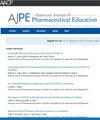增强药剂学毕业生的诊断和处方能力。
IF 3.8
4区 教育学
Q1 EDUCATION, SCIENTIFIC DISCIPLINES
引用次数: 0
摘要
这篇评论强调了诊断和处方技能对于药剂师在医疗团队中的角色至关重要。它倡导将这些技能纳入药学课程,并强调药学教育者和学术界迫切需要合作,以解决诊断和处方在主要框架和标准中被遗漏的问题,这些框架和标准包括《药剂师患者护理流程》(PPCP)、《课程成果和可委托专业活动》(COEPA)以及《药学教育认证委员会(ACPE)2025 年认证标准草案》。这篇评论借鉴了一个案例研究,即在药剂师被授予完全诊断和处方权的州,一所药学院将诊断和处方技能整合到其药学博士课程中。这一整合是通过教师主导修改 PPCP 和 COEPA 实现的,使诊断和处方成为课程的明确组成部分。评论最后呼吁教育机构采取行动,承认这些方面并将其纳入教育成果、认证标准和实践框架。这样做可以重塑药学教育的未来,从而改善患者护理,推动药学专业向前发展。本文章由计算机程序翻译,如有差异,请以英文原文为准。
Empowering Pharmacy Graduates to Diagnose and Prescribe
This commentary underscores the diagnosis and prescribing skills essential to the pharmacists’ role on the healthcare team. It advocates for the integration of these skills into pharmacy curricula and emphasizes the urgent need for collaboration among pharmacy educators and the academy to address the omission of diagnosis and prescribing from key frameworks and standards, including the Pharmacists’ Patient Care Process (PPCP) and the Curricular Outcomes and Entrustable Professional Activities (COEPA). The commentary calls on colleges and schools of pharmacy to recognize and incorporate these aspects into curricular outcomes, and urges the American Association of Colleges of Pharmacy and the Joint Commission of Pharmacy Practitioners to integrate them into practice frameworks. By taking these steps, we can reshape the future of pharmacy education, enhancing patient care and advancing the profession. The commentary also includes a case study of one college of pharmacy’s integration of diagnosis and prescribing skills into its PharmD curriculum, in a state where pharmacists were granted full diagnostic and prescriptive authority. The integration was achieved through faculty-led modifications to the PPCP and COEPA, making diagnosis and prescribing an explicit part of the curriculum.
求助全文
通过发布文献求助,成功后即可免费获取论文全文。
去求助
来源期刊
CiteScore
4.30
自引率
15.20%
发文量
114
期刊介绍:
The Journal accepts unsolicited manuscripts that have not been published and are not under consideration for publication elsewhere. The Journal only considers material related to pharmaceutical education for publication. Authors must prepare manuscripts to conform to the Journal style (Author Instructions). All manuscripts are subject to peer review and approval by the editor prior to acceptance for publication. Reviewers are assigned by the editor with the advice of the editorial board as needed. Manuscripts are submitted and processed online (Submit a Manuscript) using Editorial Manager, an online manuscript tracking system that facilitates communication between the editorial office, editor, associate editors, reviewers, and authors.
After a manuscript is accepted, it is scheduled for publication in an upcoming issue of the Journal. All manuscripts are formatted and copyedited, and returned to the author for review and approval of the changes. Approximately 2 weeks prior to publication, the author receives an electronic proof of the article for final review and approval. Authors are not assessed page charges for publication.

 求助内容:
求助内容: 应助结果提醒方式:
应助结果提醒方式:


